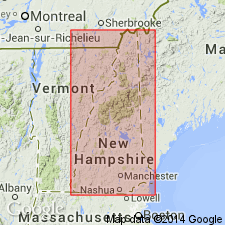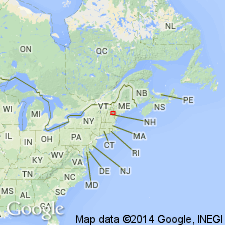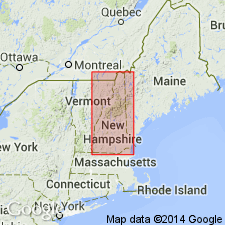
- Usage in publication:
-
- Albany Quartz Syenite*
- Modifications:
-
- Age modified
- Geochronologic dating
- AAPG geologic province:
-
- New England province
Summary:
Page F2 states that the White Mountain Plutonic-Volcanic Series has an age of Late Triassic or Early Jurassic. Isotope age determination by Tilton and others (1957) and Hurley and others (1960) yields an age of 180 m.y. [It is unclear how 180 m.y. translates into Late Triassic or Early Jurassic. The ages of the Conway Granite, Mount Osceola Granite, Mount Lafayette Granite Porphyry, Mount Garfield Porphyritic Quartz Syenite, and the Albany Quartz Syenite are inferred to be Late Triassic or Early Jurassic.]
Source: GNU records (USGS DDS-6; Reston GNULEX).

- Usage in publication:
-
- Albany Porphyritic Quartz Syenite
- Modifications:
-
- Geochronologic dating
- AAPG geologic province:
-
- New England province
Summary:
Albany porphyritic quartz syenite crops out in three ring dikes. Radiometric age of 179 +/-5 Ma obtained by K-Ar methods on rocks from northern ring dike. Age of 170 +/-3 Ma obtained using Rb/Sr methods on southern ring dike.
Source: GNU records (USGS DDS-6; Reston GNULEX).

- Usage in publication:
-
- Albany Porphyritic Quartz Syenite*
- Modifications:
-
- Age modified
- Geochronologic dating
- AAPG geologic province:
-
- New England province
Summary:
Albany Porphyritic Quartz Syenite is mapped together with Mount Garfield Porphyritic Quartz Syenite, both of the White Mountain Plutonic-Volcanic Suite, as undifferentiated porphyritic hornblende quartz syenite. Age is Jurassic based on radiometric ages of 170.3+/-3.0 Ma by Rb/Sr methods on southern ring dike, and 179+/-5 Ma by K-Ar methods on northern ring dike, both reported by Eby and others (1992), and using time scale of Harland and others (1989). Report includes geologic map, cross sections, and correlation chart.
Source: GNU records (USGS DDS-6; Reston GNULEX).

- Usage in publication:
-
- Albany Porphyritic Quartz Syenite*
- Modifications:
-
- Revised
- Age modified
- Geochronologic dating
- AAPG geologic province:
-
- New England province
Summary:
Used as Albany Porphyritic Quartz Syenite of White Mountain Plutonic-Volcanic Suite. Included with Mount Garfield Porphyritic Quartz Syenite as an unnamed quartz syenite unit. Age changed from Early and Middle Jurassic to Late Triassic(?) and Early Jurassic based on Rb/Sr age of 170+/-3 Ma (Eby and others, in press) and K-Ar age of 179+/-5 Ma (Eby and others, 1992). [Late Triassic(?) age is very tentative and was not included as part of the age of entire White Mountain Plutonic-Volcanic Suite in NH]. Report includes geologic map and correlation chart, and 1:500,000-scale map showing plutons and sample localities for age dating.
Source: GNU records (USGS DDS-6; Reston GNULEX).
For more information, please contact Nancy Stamm, Geologic Names Committee Secretary.
Asterisk (*) indicates published by U.S. Geological Survey authors.
"No current usage" (†) implies that a name has been abandoned or has fallen into disuse. Former usage and, if known, replacement name given in parentheses ( ).
Slash (/) indicates name conflicts with nomenclatural guidelines (CSN, 1933; ACSN, 1961, 1970; NACSN, 1983, 2005, 2021). May be explained within brackets ([ ]).

